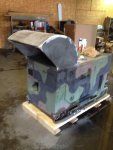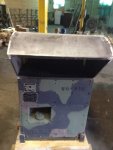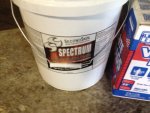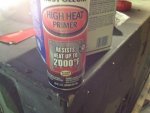...I don't know if any material is publicly available from the USN, but if you want to know about vibration dampening/ sound-deadening, nothing beats the systems on board the fleet's subs; that's the state-of-the-art.
Sylomer, used all over the place, not just Naval subs - also used to isolate entire buildings or industrial machinery from foundations. Think of how bad it would be to have a skyscraper next to a subway line, or a quiet office next to a building that has a 1000-ton stamp press...
Interestingly, it's what the floor-floating "pucks" are made from for sound isolated rooms, then rebranded by the various reseller companies.
Hi Ahab, Looked into it and the Navy touts the material to be equal to 12" of poured concrete...
Installation methods affect how this works, and it's not a single product you need, as it does little for reflection/reverberation - so still need a diffusing/absorbing layer of some other material. This is especially important if you have machinery or people who need to breath in the enclosed space. It's very easy to sound seal a room if there is nothing that needs air circulation...
...They also allowed a commercial company to produce it for commercial use. Well I found the same specs and 12" claim on a NASA spin off company named Acoustiblok and they are located in FL.
http://www.acoustiblok.com/acoustiblok-soundproofing-demonstration.php
The only catch is that the more limp they are the better they convert sound waves into energy. You have to seal every crack or the sound will escape also. I am going to see if I can get some to test.
That video clip is VERY convincing; wow. That product does the job by all appearances.
Their product is a common lead sheet replacement,
boron impregnated vinyl, boron being the high mass element they "load" the vinyl with - thus "mass loaded vinyl". Not magic, and I worry about just about any company that claims to be a spin-off on the heading of their website... I dug a bit deeper into their "NASA Registered Spin-Off" thing once I saw that emblazoned on their page, they are not registered for their use of NASA derived sound deadening technology,
they are registered for Thermablok product, which uses an Aspen Aerogel insulation package in a plastic carrier (not "novel" either, other companies do that too but don't feel the need to drag NASA into it). The loading of vinyl with boron can actually be traced back to radiation shielding in the 50's, since high mass is required for good ray and neutrino radiation shielding properties and the list of non-reactive elements with high mass is rather small...
The Acoustiblok people talk a really big game IMHO

I just looked at a home movie theater install that stated the cost @$2 a square ft for 1200 sq ft. It must be decoupled with special spacers in order for it to vibrate with sound waves to convert the sound into energy. If you could make a box to cover the entire generator you would never hear it run! Problem is you need air in and out! The price is not terrible since mass loaded butyl sheets with aluminum facing (the stuff I used on the generator) run around $4 to $6 a sq ft. Spectrum is around $6 a foot when applied @3 mm buying it by the gallon 10 sq ft for $68 + shipping and tax.
I have done home theater installations from 1995-2000, and have done some work with THX commercial theaters and industrial noise control. This technology was around back then and we bought from a company called Auralex (and many others) - only they call it
SheetBlok (important to understand that AcoustiBlok/SheetBlok are
Brand names, mass loaded vinyl is a
Trade name - like
Sheetrock is a brand name and drywall is a tradename)
They has been a company for about a decade called
QuietRock which is drywall that has a mass loaded vinyl layer pre-installed in the panel's sandwich. They also make
RF shielding panels for SCIF rooms and other uses when you need to worry about TEMPEST compatibility.
Acoustiblok's sound-source viewer is actually a
widely available noise source device - it works on the same principal as phased array radar (the kind that doesn't move). It just works on time of arrival across a known measurement of small array and uses some math to figure out which direction an impulse came from. Incidentally this is the reverse of how the GPS system works - many impulses are sent from known locations and back calculating where the possible intersections are (rejecting the improbable ones).
My point is, there are tons of companies and their "solutions" out there for sound/noise control, and it's not a new industry (most of the new guys are just rehashing old stuff). I believe it's important not to get hung up on a product or a flashy demo by a marketing guy (even a CEO touting his company's product is engaging in marketing...) - good sound control is done through good engineering and construction using
hard earned science which is very well documented. I only brought this up because of pricing being brought up - that leads down a dangerous path of assuming that you only need so much of a given product no matter the condition of the space or type of noise problem. I'm not trying to single anyone out, or claim anyone is a charlatan, I merely quoted posts to bring some calm logic and experience to the thread. As many will agree, it's been my long standing intent to bring more understanding and insight to threads rather than to get into arguments or wandering into potential product battles - I think we are all better for it when we all actually start to be knowledgeable with what we are talking about

If you're reading this thread looking for good generator enclosure or shed construction information, do a Google search for "
STC 70 Wall assembly". There are tons of practical resources that will instruct (at no charge) a lot of the best practices of building sound isolating structures - in fact the
Green Building Council is starting to consider environmental noise as part of their building guidelines, so newer homes, offices, and buildings in general will be quieter.































